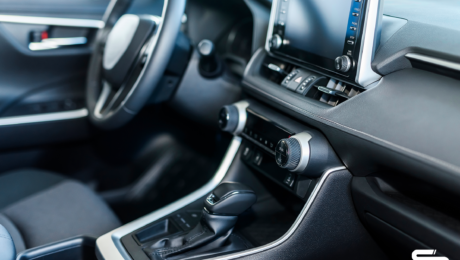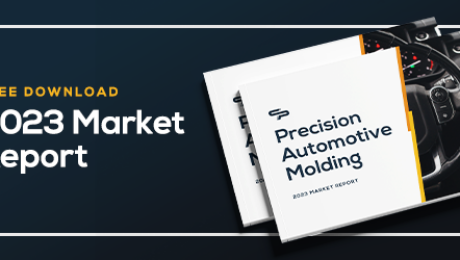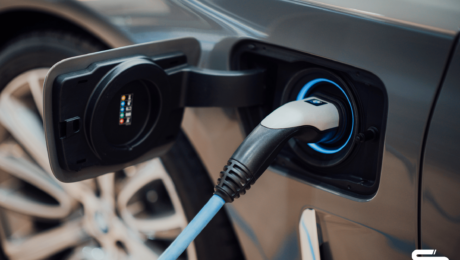Top 3 Types of Precision Molding for the Automotive Industry
Plastic injection molding for the automotive industry requires high precision and high specificity to ensure the end product meets industry standards. How do you know which type of molding is best for your particular project?
This blog will guide you through the three most common types of injection molding used for automotive industry parts. Our aim is to simplify a highly complex topic and help you get on your way with your next automotive part project.
Straight Injection Molding
Straight injection molding is the most common type of plastic processing. This type of process is so common because it can be used to create large product volumes quickly, cost-effectively, and at a consistently high quality.
How does it work? The first step is to create a digital 3D part model using computer-aided design (CAD) software. Based on the part model, tool engineers create a mold design, and mold makers create the mold based on that design. Then, during production, molten plastic is injected into the cavity of the mold. The plastic then cools and solidifies, taking its desired shape. In the final step, the part is removed from the mold, and is now ready to move along in the product manufacturing process.
Straight injection molding is used in innumerable automotive industry parts like junction relay boxes, seat belt retractor mechanism components, and electronic enclosures.
Insert Molding
Insert molding is similar to injection molding. It also involves injecting molten plastic into a mold and uses the same type of plastic materials. The difference is that during the insert molding process, an insert (or multiple inserts) is added into the mold and becomes a permanent part of the end product. Insert molding is favored for its flexibility – the addition of inserts introduces a sharp increase in the possible number of product configurations for a part.
There are four main steps in insert molding:
- Similar to injection molding, a digital part model is made. For insert molding, designers must also consider where to add the insert to ensure that it retains its orientation and stays in place.
- The insert is added into the mold. This can be done through automation or manually. Typically, automation is used for high-quantity orders, and manual insertion is used for low-quantity orders.
- The molten plastic is injected into the mold, filling the mold and adhering to the insert.
- Once cooled, the molded part is removed from the mold. The part is complete and ready for the next step in production.
Insert molding is a common production process of automotive part manufacturing, such as sensor housings, switch components, and automotive electronic housings.
Multishot (2k/3k) Molding
The final molding process that’s popular for producing automotive parts is multishot molding. Multishot molding is used to create complex parts with multiple plastic materials. There are many types of multishot molding, but 2k and 3k are the most common.
In 2k molding, sometimes called two-shot or two-component molding, two different plastic materials are injected into a mold to make one part. In 3k (or three-shot or three-component) molding, three unique plastic materials are injected into one mold.
The process is the same as straight injection molding, with some extra steps: after the first material is injected into its cavity and cooled, the mold opens and rotates to the second cavity position, at which point the mold closes and a second material is injected into a second cavity. That’s 2k molding. For 3k molding, the process continues – the injected material is cooled, the mold opens and rotates, and a third material is injected into a third cavity.
Multishot molding is used to create a part with two or more distinctive features, like multiple colors or textures (e.g., hard outer shell and soft-touch inner surface). Parts made with multishot molding can be seen in many types of auto parts, like rain and light sensors, pedal arms, and instrument bezels.
Automotive Industry Molding at Chemtech
At Chemtech, creating specialized parts for the automotive industry is our specialty. With four decades of experience and a world-class facility, we are well-prepared to meet the rigid demands of the automotive industry for volume and quality. We employ custom molding machines, specialized material drying equipment, hot runner controllers, and mold temperature regulators to ensure that our equipment is easily able to perform to our automotive customers’ high expectations.
We apply this equipment on numerous materials that are commonly required in the automotive industry:
- Nylon (PA6 or PA66)
- Polyester (PBT)
- Polycarbonate (PC)
- Polycarbonate-ABS (PC/ABS)
- Polyoxymethylene (POM)
- Polyphthalamide (PPSU; brand name Radel®)
Chemtech offers straight injection, insert molding, and multishot (2k and 3k) capabilities. Contact us today to start your project.
- Published in Automotive
Driving Excellence: How Chemtech Supports the Automotive Industry
Quality Precision
As automotive technology continues to advance, these changes promote the development of more complex and technically challenging injection molded components. Within these components are intricate processes and materials. Chemtech looks to support automotive industry clients in creating these complex components. With our in-house mold design, CAE mold simulation software, DFM analysis, a dedicated project engineer, APQP, and additive in-house 3D printing. This blog will discuss how we fulfill components and the processes that go into them.
At Chemtech Plastics, we produce several automotive components:
- Accelerator pedals
- Rain LT sensor
- Throttle by wire switch
- Optical lenses
- Occupant safety systems
- Lever stalks
- Multifunction switches
- Power window switches
- Directional components
- Light pipes
- Automotive fuel system components
- Audio/in-ear monitoring
Rain LT Sensor
The Rain Light Sensor is a 3-shot (3K) component that is used across multiple vehicle platforms. This component provides signals to enable headlights and windshield wipers, adjust HVAC temperatures, deploy Driver Assist, and other safety functions.
This mold requires a challenging 0.2-gram shot weight of clear resin portion. A specialized molding cell is specifically sized for this application. The mold opens once the first and second materials are injected into the mold. These two molded components are then rotated into position for the third material to be injected.
Following the process, the parts are retrieved and transported by robots into thermoformed trays designed for this application. This part is then inspected for blemishes or imperfections as it’s an optical surface. Chemtech has supplied this part for over 10 years, defect-free.
Junction Relay Box
The junction relay box is a complicated component, as it includes over 100 terminal pockets, and it can be difficult to get the material to flow into these small locking features.
As a part of the molding requirements, the Junction relay box requires hundreds of small mold inserts with very tight dimensional requirements. These inserts are extremely fragile and have a unique design.
The shut-off between two of these inserts can be a quarter-degree shut-off angle requiring the inserts to be machined and held in positions to within one ten-thousandth of an inch (0.0001). Maintaining and assembling these tools require a special level of skill.
2-Shot Housing Cover
Our 2-shot (2K) housing cover is used to contain the accelerator pedal for the throttle-by-wire system, which we can also produce. This part requires a specialized molding press to have the second material in the mold’s cavity and core side.
This is accomplished through a rotating center plate that captures a small portion of the exterior surface. The plate transports the first shot to the second shot position. In this position, both new cavity and core details are located in the first shot.
Further complexity comes from the first shot resin that is 50% glass-filled polypropylene and 10 mm long glass fibers. This material can be abrasive and cause steel wear. A specific aerospace plating is applied permanently to the mold surface to counteract this.
Chemtech Advantage
The Chemtech team works closely with automotive manufacturers to design and manufacture high-quality components. Our utilization of cutting-edge technologies and methodologies enables us to fabricate precise, lightweight plastic injection-molded components. These components have applications across diverse automotive sectors, encompassing interior and exterior trim, lighting systems, engine elements, and more.
Ready to see what Chemtech can do?
Let’s start a project together. Request your free quote today.
- Published in Automotive
2023 Market Report: Precision Automotive Molding
Our 2023 Precision Automotive Molding Market Report covers everything:
Market shifts
Impact of the pandemic on the manufacturing landscape
New trends advancing the automotive plastics market and manufacturing spaces.
Download the free report to learn more.
- Published in Automotive
The Future of Electric Vehicles in the Automotive Industry
The automotive industry is going through a major shift—bringing with it new challenges, such as increased regulation, changing consumer preferences, and the need to reduce emissions. Currently, the most significant trend is the rise of electric vehicles (EVs), which are gaining in popularity due to their numerous benefits.
EVs are more environmentally friendly, have lower operating costs, and provide a smoother and quieter ride. Recent years have shown a significant increase in the production and sales of EVs, with major automakers investing heavily in their development and production and governments pushing for the adoption of EVs through various incentives, such as tax credits, rebates, and subsidies.
While electric vehicles still face several challenges, their rising popularity is likely to accelerate in the coming years, as automakers continue to invest in their development and governments implement policies to encourage their adoption. Chemtech Plastics’ extensive history in the automotive industry gives them a unique perspective on the future of electric vehicles.
Benefits of electric vehicles
Electric vehicles offer several advantages over traditional gasoline-powered cars, including lower emissions, reduced operating costs, better performance, and an improved driving experience.
- Lower emissions: Electric vehicles produce zero emissions at the tailpipe. This means they don’t emit harmful pollutants into the air, thus reducing air pollution and helping to combat climate change.
- Reduced operating costs: EVs are generally cheaper to operate and maintain than gasoline-powered cars. They have fewer moving parts, which reduces the likelihood of breakdowns and expensive repairs. The cost of electricity used to power an EV is typically much lower than the cost of gasoline, and EV owners can take advantage of government incentives, such as tax credits and rebates, to further reduce costs.
- Better performance: Electric vehicles have instant torque, which means they can accelerate quickly and smoothly. This is especially beneficial in urban areas where stop-and-go traffic is common. EVs also have a lower center of gravity, which can improve handling and stability.
- Less noise pollution: Across the board, EVs are generally quieter and smoother. There is no noise with an EV engine, and the lack of vibration can make the driving experience more comfortable.
As battery technology continues to improve, EVs are becoming more practical and affordable, making them an attractive option for consumers looking for a cleaner and more cost-effective mode of transportation. The latest advancements in the industry include increased battery ranges, faster charging times, exploration of wireless charging, battery swapping programs, and investments in charging infrastructure.
What’s in store for electric vehicles?
The potential for continued growth in the electric vehicle market is significant, with experts predicting that adoption and production will only continue to increase. Contributing to this growth are government policies, decreasing costs, and investments by major automakers.
Many countries have already set ambitious targets for the adoption of electric vehicles. Some have even proposed bans on the sale of new gasoline-powered cars in the coming years. New government policies are aimed at reducing carbon emissions and promoting sustainable transportation.
The cost of EVs and batteries is also decreasing, as technology continues to improve and economies of scale kick in. Electric vehicle prices are expected to become increasingly competitive with traditional gas-powered cars. The International Energy Agency (IEA) predicts that the number of EVs on the road will grow from 10 million in 2020 to 145 million by 2030.
When coupled with low maintenance costs and increased government incentives, electric vehicles become increasingly desirable to consumers in the market for a new car. For consumers, tax credits and rebates make EVs more affordable. Meanwhile, automakers are incentivized to prioritize EV production and to devote more time to developing and producing more sustainable, fuel-efficient vehicles and alternative fuel options.
What does this mean for automakers?
Transitioning to an EV-dominated market is full of potential benefits for a cleaner and more sustainable transportation system. However, this transition poses significant challenges for automakers, such as:
- Battery technology: Battery technology is critical for EVs, and automakers need to invest heavily in research and development to develop batteries that can provide long-range, fast charging, and high performance.
- Infrastructure: Widespread adoption of EVs will require a significant investment in charging infrastructure. Automakers will need to work with governments and other stakeholders to build a network of charging stations that can support the growth of EVs.
- Supply chain: Automakers need to establish new relationships with suppliers of battery components, electric motors, and other EV-specific parts.
- Workforce: Moving to EVs will require automakers to train and retrain their workforce to handle the new technology, including engineers, technicians, and assembly line workers.
- Consumer acceptance: Consumer acceptance is critical to the success of electric vehicles. Automakers need to invest in marketing and education to help consumers understand the benefits of EVs and overcome any concerns they may have.
- Regulatory environment: Automakers need to work with governments to develop policies that support the growth of EVs, such as tax incentives, subsidies, and emissions regulations.
- Legacy operations: Many automakers still have legacy operations focused on traditional internal combustion engine (ICE) vehicles. The transition to an EV-dominated market will require significant investments to retool and reconfigure these operations to produce EVs instead.
Impact on the automotive industry
Turning toward electric vehicles has the potential to create both job losses and job opportunities in a variety of industries. While the traditional automotive industry may face some challenges, the emergence of new industries and jobs related to EVs could lead to significant growth and innovation, potentially leading to new business models and opportunities.
New industries and jobs are already emerging, such as the skilled workforce needed for the production of lithium-ion batteries used in electrical vehicles. Further jobs will be created for the installation and maintenance of charging stations and the development of software and technologies to optimize charging networks.
As the demand for gasoline decreases, oil and gas companies may need to adjust their business models to remain profitable. Some examples of alternative sources of revenue include renewable energy production and the development of new technologies for electric vehicles or charging infrastructure.
The electric industry will certainly benefit from some additional help. As more EVs hit the road, there will be an increased demand for electricity, especially during peak charging times. The strain on the existing grid infrastructure will require upgrades to support the growing demand, but it will also create an opportunity to develop and offer new products and services.
Importance of automotive industry professionals
Chemtech Plastics specializes in designing and manufacturing high-quality plastic components for various industries, including automotive. Our expertise in automotive plastics has made us a valuable partner to automotive manufacturers, providing innovative solutions that improve efficiency and performance for our clients.
The Chemtech team works closely with automotive manufacturers to design and manufacture components that are both functional and aesthetically pleasing. We use advanced technologies and techniques to create precision, plastic injection-molded parts that are durable, lightweight, and able to withstand harsh environmental conditions. The parts we manufacture are used in various automotive applications, including interior and exterior trim, lighting systems, engine components, and more.
Ready to see what Chemtech can do? Let’s start a project together. Request your free quote today.
- Published in Automotive








